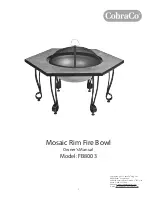
INSTALLATION INSTRUCTIONS – CLOSED CIRCUIT SERIES
32
If the system is unable to take the correct amount of fluid then further investigation will be required to determine if the
HartStat OTP valve has closed or if there is a blockage in the system.
Note:
Closed circuit systems with copper header and riser collectors (Bt, CSA2007, CSA2013, L, LCS) will have a closed
circuit volume and percentage fluid concentrate volume (columns 5 to 8) slightly less than the figures in the table above.
These systems will also have a 4.5 litre heat transfer fluid concentrate percentage figure (column 4) slightly higher than the
figures in the table above.
Instructions detailing the closed circuit commissioning process commences on page 33.
PRECAUTIONS WITH HARTGARD FOR BUILDING WITH RAINWATER TANKS
While Hartgard is non-toxic to humans, it does have an adverse effect on water stored in rainwater tanks. Hartgard will kill
microscopic algae that is typically present in rainwater tanks. This may then render the rainwater foul and unfit for human
consumption. Solahart recommends that installers ensure that rainwater tanks cannot be contaminated with Hartgard
solution. Before installing a closed circuit system, the installer should determine whether the run-off from the roof on
which the system will be mounted, is collected in a rainwater tank.
If this is the case, then the section of gutter immediately beneath the proposed location of the new Solahart system should
be isolated from the rainwater collection system. This can be done by blocking that section of gutter from the remaining
gutter, and fitting a separate down pipe to take any run-off water from that section of roof away to waste. If this is not
practical for a specific installation, then the installer should discuss the possible options with the home owner.
This should be done prior to installing the new system, so that any leak or spillage during installation does not make its
way into the rainwater tank. If a rainwater tank does become contaminated, then the following actions are necessary to
return the water supply to a consumable state.
a.
Correct the leak or spillage.
b.
Wash down the roof area where the spill or leak has occurred.
c.
Flush out the gutters and down pipes.
d.
Empty the rainwater tank, and clean out all algae from the inside of the tank.
e.
Refill the rainwater tank with fresh water.
CLOSED CIRCUIT SYSTEMS – END CAP
The end cap is supplied fitted to the ‘tail’ end of the tank. The end cap used should not need to be removed to complete the
installation.
Removing the End Cap
If it is necessary to remove the end cap:
•
Remove the screw from the end cap
•
Using a flat faced screwdriver, gently lever the end cap out of its recess from the key slot at the bottom of the end cap.
Fitting the End Cap
To fit the end cap:
•
Position the end cap in the jacket end recess, lining up the slot at the bottom of the end cap with the key on the jacket
end.
•
Gently push into the recess so the end cap engages with the ridges on the jacket end.
•
Secure the end cap with the screw provided, taking care not to over tighten the screw.
Only use the screw provided.
End cap closed circuit system
Position end cap over recess and insert
Secure end cap with screw
Содержание 151J
Страница 44: ...44 INSTALLATION DIAGRAMS MODELS 151J 181J 181LCSC 181BTC 151J 181J 181LCSC 181BTC J collector illustrated ...
Страница 45: ...45 INSTALLATION DIAGRAMS MODELS 151L 181L 151L 181L ...
Страница 46: ...46 INSTALLATION DIAGRAMS MODELS 302J 302LCSC 302BTC 303J 302J 302LCSC 302BTC 303J J collectors illustrated ...
Страница 47: ...47 INSTALLATION DIAGRAMS MODELS 302L 303L 302L 303L ...
Страница 51: ...CONNECTION DETAILS 51 With Pitch Tiled Roof Mounting ...
Страница 58: ...58 This page is intentionally blank ...
Страница 59: ...59 This page is intentionally blank ...
















































